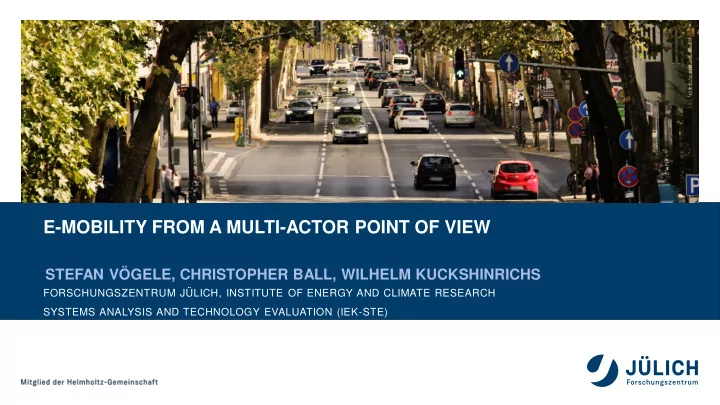

E-MOBILITY FROM A MULTI-ACTOR POINT OF VIEW STEFAN VÖGELE, CHRISTOPHER BALL, WILHELM KUCKSHINRICHS FORSCHUNGSZENTRUM JÜLICH, INSTITUTE OF ENERGY AND CLIMATE RESEARCH SYSTEMS ANALYSIS AND TECHNOLOGY EVALUATION (IEK-STE)
OUTLINE 1. Introduction 2. Method 3. Results 4. Conclusions
BACKGROUND German Government targets: 1 million e-vehicles by 2020 & 6 million by 2030 90.000 NO. OF ELECTRIC CARS IN GERMANY 80.000 Policies supporting e-mobility: 70.000 60.000 • Purchase grant 50.000 • Financial support for 40.000 charging infrastructure 30.000 20.000 • Tax incentives 10.000 0 2006 2008 2010 2012 2014 2016 2018 Source: www.kba.de Slow diffusion of e-vehicles in Germany Page 3
INTRODUCTION Hypothesis : A successful deployment of e-mobility requires support by a broad range of actors (including car-manufactures, government, car- users and utilities) whereas each actor has its specific interests Multi-Actor Multi-Criteria Problem Research questions: • Which factors underlie an actor's decision in favour of a particular technology? • What has to change to effect a shift from one technology to another? • How is a stakeholder's decision influenced by the position of other stakeholders? Page 4
2. METHOD Multi-Actor Multi-Criteria Approach Assumptions: • 4 actors: car users, government, car manufacturers and electricity suppliers, who each must choose one mobility option • 3 Mobility options: Internal combustion engine vehicles (ICE) Hybrid vehicles (HEV) E-vehicles (EV) Page 5
2. METHOD MCDA - Steps (1) Identification of factors being relevant for decision of actors (2) Specification of actor-specific weighting factors (3) Assignment of values to characteristics of technology options (4) Normalization [0-1] (5) Weighting and summing up Selection of the option with best performance Extension: Externalities as additional factors Page 6
2. METHOD - FACTORS BEING RELEVANT FOR ACTORS Car Electricity Characteristics Car user Government manufactures suppliers ECOLOGICAL FACTORS CO 2 emissions X X X X Local emissions X ECONOMIC FACTORS Cost of ownership X X Profit X X X Employment X X SOCIAL/POLITICAL FACTORS Impact on import dependency X X Impact on the security of electricity supply X X Comfort/Performance Charging time X X X Range X X X Other X OTHER FACTORS Complementarity with existing structures X X X X Need for incentives X X X X Page 7
2. METHOD – WEIGHTINGS (CAR-USERS) Source: Own compilation based on [Esch, 2016] Page 8
2. METHOD CHARACTERISTICS OF OPTIONS Car with internal Characteristics unit Electric Car Hybrid Car combustion ECOLOGICAL FACTORS CO 2 emissions* - 63** 100 78 Local emissions* - 0 100 79 ECONOMIC FACTORS Cost of ownership* - 107 100 101 Profit* - 50 100 90 Employment* - 26 100 104 SOCIAL/POLITICAL FACTORS Impact on import dependency - very low very high high Impact on the security of electricity supply - moderate very low very low Comfort/Performance Charging time - very bad very good very good Range km 350 900 1000 Other 2 Good very good very good OTHER FACTORS Complementarity with existing structures very low very good very good Need for incentives very high very low low Remarks: * Standardized ICE = 100, ** Calculated based on data on average CO2-emissions/kWh in Germany, sources: Own compilation based on [Esch, 2016, NISSAN Center Europe, 2018, Toyota Deutschland, 2018] Page 9
2. METHOD – EXTENSION Indirect effects and externalities can change certain stakeholders' decisions Externalities: Learning effect, reduction in cost, increases in comfort and improvements in charging infrastructure as side effects/ancillary benefits Page 10
3. RESULTS AND SENSITIVITY ANALYSIS Without externalities Government and electricity suppliers prefer e-vehicles; manufacturers and car users prefer ICE Page 11
3. RESULTS AND SENSITIVITY ANALYSIS Round 1: Including externalities: i.e. government Round 2: Second Order externalities included & supplier support e-vehicles impacts on car- users (e.g. improvement in recharging infrastr.) Manufacturers shift to hybrid vehicles if the The inclusion of externalities causes car users to positive attitude of car users towards hybrids is shift from ICEs to hybrid vehicles included Page 12
SENSITIVITY ANALYSIS What would cause manufacturers to switch to e-vehicles? Higher weighting for ecological factors and/or improvement of CO 2 footprint of electricity used in e-vehicles • • Harmonization of profit margins among all vehicles Page 13
SENSITIVITY ANALYSIS What would cause users to switch to e-vehicles? Lower importance of comfort and performance: e- More importance for ecological factors (i.e. thanks to vehicles do better greater awareness) Source: www.spiegel.de/fotostrecke/fridays-for-future-die-bewegung-in-bildern-fotostrecke- Source: www.smarter-fahren.de/elektroautos-laden) 169421-3.html Page 14
CONCLUSIONS It is important to consider co-benefits associated with policies to understand the position • of each decision maker Car users and manufacturers show the most resistance to e-vehicles, but this resistance • can be reduced through externalities It is possible to cause car users to switch to hybrid vehicles, a switch to e-vehicles • seems to be difficult Profitability is the biggest hurdle for manufacturers to go for e-vehicles • Next steps: Consideration of different groups of car users • Page 15
Recommend
More recommend